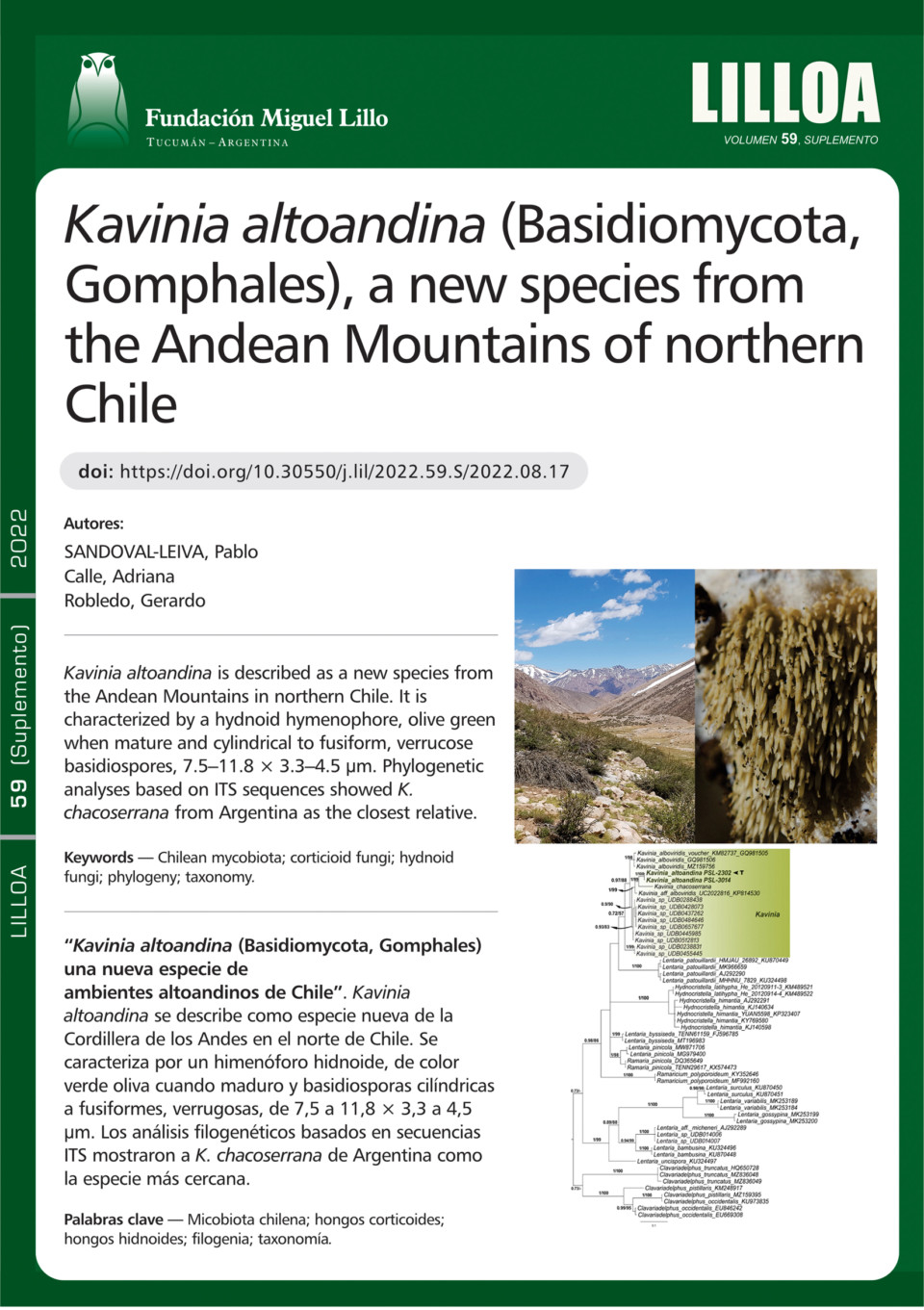Kavinia altoandina (Basidiomycota, Gomphales), a new species from the Andean Mountains of northern Chile
DOI:
Keywords:
Chilean mycobiota, corticioid fungi, hydnoid fungi, phylogeny, taxonomyAbstract
Kavinia altoandina is a new species from the Andean Mountains in northern Chile. It is characterized by a hydnoid hymenophore that is white to cream when young but olive green when mature, as well as by the cylindrical to fusiform, verrucose basidiospores, 7.5?11.8 × 3.3?4.5 ?m. In addition, phylogenetic relationships inferred from internal transcribed spacer (ITS) sequences support K. altoandina as a new species related to K. chacoserrana from Argentina.
Downloads
References
Bernicchia, A. & Gorjón, S. P. (2010). Corticiaceae s.l. Ed. E. Candusso, 2010, vol. 12, 1008 pp.
Boidin, J. & Gilles, G. (2000). Le genre Kavinia Pilat (Basidiomycotina). Cryptogamie Mycologie 21: 139-143. https:// doi.org/10.1016/S0181-1584(00)01040-X
Dogan, H. H. (2009). Two new lignicolous fungi additions to Turkey mycota. SDU Journal of Science 4 (1): 5-39.
Eriksson, J. & Ryvarden, L. (1976). The Corticiaceae of North Europe: Hyphodermella – Mycoacia (Vol.4). Fungiflora, Oslo.
Giachini, A. J., Hosaka, K., Noura, E. R., Spatafora, J. W., & Trappe, J. M. (2010). Phylogenetic relationships of the Gomphales based on nuc- 25S-rDNA, mit-12S-rDNA and mit-ATPg-DNA combined sequences. Fungal Biology 114: 224–234. https://doi.org/10.1016/j.funbio.2010.01.002
Hoang, D. T., Chernomor, O., von Haeseler, A., Minh, B. Q. & Vinh, L. S. (2018). UFBoot2: Improving the Ultrafast Bootstrap Approximation. Molecular Biology and Evolution 35 (2): 518-522. https://doi.org/10.1093/molbev/msx281
Hosaka, K., Bates, S. T., Beever, R. E., Castellano, M. A., Colgan, W., Dominguez, L. S., Nouhra, E. R., Geml, J., Giachini, A. J., Kenney, S. R., Simpson, N. B., Spatafora, J. W., & Trappe, J. M. (2006). Molecular phylogenetics of the gomphoid-phalloid fungi with an establishment of the new subclass Phallomycetidae and two new orders. Mycologia 98 (6): 949-959. https://doi.org/10.3852/mycologia.98.6.949
Hyde, K., Udayanga, D., Manamgoda, D.S., Tedersoo, L., Larsson, E., Abarenkov, K., Bertrand, Y., Oxelman, B., Hartmann, M., Kauserud, H., Ryberg, M., Kristiansson, E. & Nilsson, R. H. (2013). Incorporating molecular data in fungal systematics: a guide for aspiring researchers. Current Research in Environmental & Applied Mycology 3 (1): 1-32. https://doi.org/10.5943/cream/3/1/1
Kalyaanamoorthy, S., Minh, B. Q., Wong, T., von Haeseler, A. & Jermiin, L.S. (2017). ModelFinder: fast model selection for accurate phylogenetic estimates. Nature Methods 14 (6): 587-589. https://doi.org/10.1038/nmeth.4285
Katoh, K. & Standley, D. M. (2013). MAFFT Multiple Sequence Alignment Software Version 7: Improvements in Performance and Usability. Molecular Biology and Evolution 30 (4): 772-780. https://doi.org/10.1093/molbev/mst010
Kout, J. & Hajšmanová, P. (2015). Kavinia alboviridis in the Czech Republic. Czech. Mycology 67 (1): 59-67. https://doi.org/10.33585/cmy.67107
Larsson, K. H. (2007). Re-thinking the classification of corticioid fungi. Mycological Research 111 (9): 1040-1063. https://doi.org/10.1016/j.mycres.2007.08.001
Lodge, D. J., Ammirati, J. F., O´Dell, T. E., Mueller, G. M., Hunhdorf, S. M., Wang, C. J., Stokland, J. N., Schmit, J. P., Ryvarden, L., Leacock, P. R., Mata, M., Umaña, L., Wu, Q. & Czederpiltz, D. L. (2004). Terrestrial and lignicolous macrofungi. In G. M. Mueller, G.F. Bills, & M.S. Foster (Eds.), Biodiversity of fungi: inventory and monitoring methods (1st ed., pp. 127-172). Elsevier Academic Press.
Miller, M. A., Pfeiffer, W. & Schwartz, T. (2010). Creating the CIPRES Science Gateway for inference of large phylogenetic trees. 2010 Gateway Computing Environments Workshop (GCE), New Orleans, LA. https://doi.org/10.1109/GCE.2010.5676129
Minh, B. Q., Hahn, M. W. & Lanfear, R. (2020). New Methods to calculate concordance factors for Phylogenomic Datasets. Molecular Biology and Evolution 37 (9): 2727-2733. https://doi.org/10.1093/molbev/msaa106
Natarajan, K. & Kolandavelu, K. (1985). Kavinia globispora sp. nov. Transactions of the British Mycological Society 84 (2): 362-363. https://doi.org/10.1016/S0007-1536(85)80094-2
Nguyen, L. T., Schmidt, H. A., von Haeseler, A. & Minh, B. Q. (2015). IQ-TREE: A Fast and Effective Stochastic Algorithm for Estimating Maximum-Likelihood Phylogenies. Molecular Biology and Evolution 32 (1): 268-274. https://doi.org/10.1093/molbev/msu300
Robledo, G. & Urcelay, C. (2017). Kavinia chacoserrana sp. nov. (Gomphales, Basidiomycota): a new species from South America based on morphological and molecular data. Mycosphere 8 (6): 1028-1034. https://doi.org/10.5943/mycosphere/8/6/3
Robledo, G. L., Palacio, M., Urcelay, C., Vasco-Palacios, A. M., Crespo, E., Popoff, O., Põldmaa, K., Ryvarden, L. & Costa-Rezende, D. H. (2020). Mystery unveiled: Diacanthodes Singer – a lineage within the core polyporoid clade. Systematics and Biodiversity 18 (6): 538-556. https://doi.org/10.1080/14772000.2020.1776784
Robledo, G., Nakasone, K. K. & Ortiz-Santana, B. (2021). Bjerkandera carnegieae comb. nov. (Phanerochaetaceae, Polyporales) a wood-decay polypore of cactus. Plant and Fungal Systematics 66 (2): 230-239. https://doi.org/10.35535/pfsyst-2021-0021
Ronquist, F., Teslenko, M., van der Mark, P., Ayres, D. L., Darling, A., Höhna, S., Larget, B., Liu, L., Suchard, M. A. & Huelsenbeck, J. P. (2012). MrBayes 3.2: Efficient Bayesian Phylogenetic Inference and Model Choice Across a Large Model Space. Systematic Biology 61 (3): 539-542. https://doi.org/10.1093/sysbio/sys029
Rossman, A. Y., Tulloss, R. E., O´Dell, T. E. & Thorn, R. G. (1998). Protocols for an all taxa biodiversity inventory of fungi in a Costa Rican conservation area. Parkway Publishers
Sandoval-Leiva, P., Niveiro, N., Urbina-Casanova, R. & Scherson, R. (2017). Lichenomphalia altoandina, a new species of Hygrophoraceae from the Chilean Altiplano. Mycologia 109 (1): 92-99. https://doi.org/10.1080/00275514.2017.1281682
Tamura, K., Stecher, G., Peterson, D., Filipski, A. & Kumar, S. (2013). MEGA6: Molecular Evolutionary Genetics Analysis Version 6.0. Molecular Biology and Evolution 30 (12): 2725-2729. https://doi.org/10.1093/molbev/mst197
Thiers, B. (2022, continuously updated). Index Herbariorum: a global directory of public herbaria and associated staff. New York Botanical Garden´s Virtual Herbarium. Recuperado de http://sweetgum.nybg. org/ih
Troncoso, S., Casanova-Katny, A., Marin, C. & Palfner, G. (2020). Nuevos registros de hongos desertícolas en los Parques Nacionales Nevado Tres Cruces y Pan de Azúcar, Región de Atacama, Chile. Gayana Botánica 77 (1): 67-72. https://doi.org/10.4067/s0717-66432020000100067
White, T., Bruns, T. D., Lee, S. & Taylor, J. (1990). Amplification and direct sequencing of fungal ribosomal RNA genes for phylogenetics. In: Innis MA, Gelfand DH, Sninsky JJ, White TJ, eds. PCR protocols: a guide to methods and applications. San Diego, California: Academic Press. 315-322 p.
Downloads
Published
How to Cite
Issue
Section
License
Copyright (c) 2022 Lilloa

This work is licensed under a Creative Commons Attribution-NonCommercial-NoDerivatives 4.0 International License.










